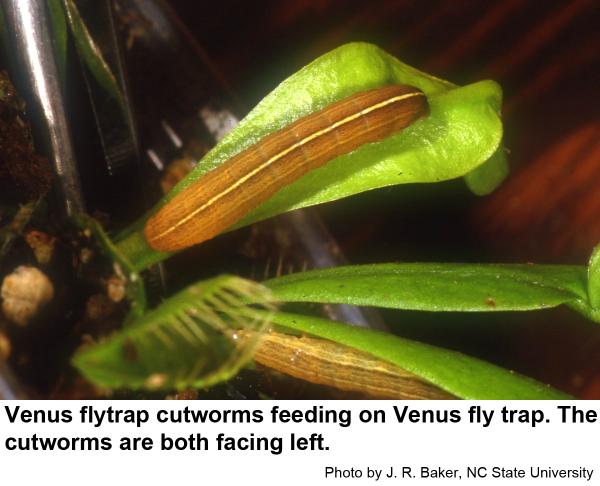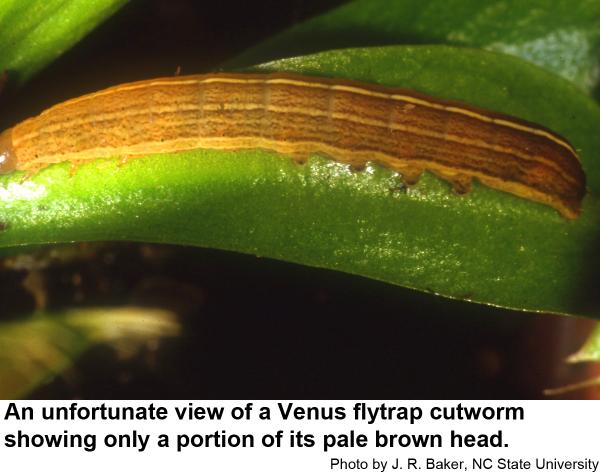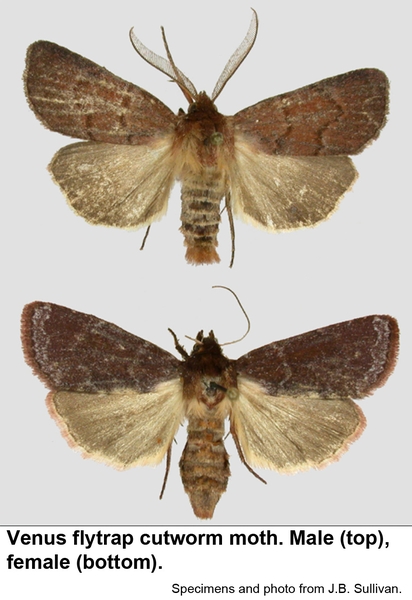Description and Biology
Venus flytrap cutworms, Hemipachnobia subporphyrea, are light brown caterpillars with a narrow, distinct, pale yellow stripe down the back outlined by darker brown lines. A faint yellow line outlined by slightly darker brown lines occurs on either side of the back. A relatively dark brown, narrow line down each side separates the pale undersides from the brown top side. It is likely that these mature cutworms crawl to the soil surface and dig in to pupate the following spring. In late March to early May, reddish brown moths emerge to mate and lay eggs. The wingspan is about 11/2 inches. Females have slender antennae whereas the antennae of males are feathered. Moths are most abundant in April. We have one generation per year here in North Carolina. The Venus flytrap cutworm is confined to the fragmented distribution of Venus fly taps and the population is considered extremely reduced. Colonies are clustered in wet pine savannas, a habitat that needs fire to persist,
Host Plants
Appropriately enough, Venus flytrap cutworms have only been collected while feeding on Venus fly traps and has been reared on sundew. However, the related sundew dart, Hemiachynobia monochromatea, switches to plants in the blueberry family in its late stages so Venus flytrap cutworms may do likewise.
Residential Recommendations
Since few residences exist in wet pine savanas and since the venus flytrap cutworm is an endangered species, control recommendations for Venus flytrap cutworms are not recommended for homeowners. Commercial Venus flytrap growers may occasionally find this cutworm to be a destructive pest. The North Carolina Agricultural Chemicals Manual has numerous pesticides listed for caterpillar control on commercial crops.
Other Resources
- Endangered and Threatened Wildlife and Plants; Animal Candidate Review for Listing as Endangered or Threatened Species. Anonymous. 1994. Publication: U. S. Fish and Wildlife Service.
Hemipachnobia subporphyrea - (Walker, 1858), Venus Flytrap Cutworm. Schweitzer, D.F. 2011. Nature Serve Explorer. - Hemipachnobia subporphyrea (Walker, 1858) - Venus Flytrap Cutworm Moth. Hall, S. et al. 2023 (pdf early draft). Moths of North Carolina.
- Extension Plant Pathology Publications and Factsheets
- Horticultural Science Publications
- North Carolina Agricultural Chemicals Manual
For assistance with a specific problem, contact your local Cooperative Extension Center
This factsheet has not been peer reviewed.
Publication date: Nov. 14, 2018
Reviewed/Revised: Aug. 25, 2023
N.C. Cooperative Extension prohibits discrimination and harassment regardless of age, color, disability, family and marital status, gender identity, national origin, political beliefs, race, religion, sex (including pregnancy), sexual orientation and veteran status.



